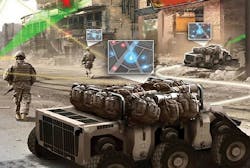Army surveys industry for the latest artificial intelligence research for cyber and electronic warfare
ABERDEEN PROVING GROUND, Md. – U.S. Army researchers are surveying industry to determine the state of the art in artificial intelligence technologies for electronic warfare, cyber warfare, signals intelligence, and big-data analytics.
Officials of the Army Contracting Command at Aberdeen Proving Ground, Md., issued a request for information on Tuesday (W56KGU-18-X-A515) for the Artificial Intelligence and Machine Learning Techniques, Algorithms, and Capabilities project.
The RFI is to obtain market research from academia, industry, and government agencies on internally- and externally funded independent research in artificial intelligence (AI), machine learning (ML), cognitive computing (CC) and data analytics (DA) techniques, algorithms, and capabilities that have application to Army research.
The Army contracting command issued this notice on behalf of the Intelligence And Information Warfare Directorate of the Army Communications-Electronics Research, Development And Engineering Center at Aberdeen Proving Ground, Md.
Related: Electronic warfare evolves to meet new threats
Specifically, the Army wants to know how these enabling technologies could improve military applications in electronic warfare (EW); intelligence, surveillance, and reconnaissance (ISR); reconnaissance, surveillance, and target acquisition (RSTA); offensive cyber operations (OCO); signals intelligence (SIGINT); processing, exploitation and dissemination (PED); and big data analytics.
Army researchers established a cognitive-computing and machine-learning team in March 2017 to help identify artificial intelligence technologies that could enhance Army operations, in EW, ISR, RSTA, OCO, SIGINT, PED, and data analytics.
Army researchers week greater insight into artificial intelligence techniques, algorithms and capabilities to determine areas of AI research suitable for investment and eventual integration into next-generation Army SIGINT/Cyber/EW/ISR systems.
For these purposes, electronic warfare includes survivability EW, offensive EW, electronic support, reconnaissance and surveillance, electronic attack, and battle damage assessment.
Related: Future cyber warfare: protecting the grid
Offensive cyber operations include cyber electromagnetic activities, ISR, situational understanding, operational preparation of the environment, and battle damage assessment.
Signals intelligence includes detect, identify, exploit, direction finding, and geolocation; radar; ISR, RSTA; counter-fire target acquisition; sensor data processing; and intelligence analyst assistance with a digital teammate.
Army researchers also are interested in industry research into big-data artificial intelligence frameworks; autonomous decision making for manned and unmanned operations; and foundational tools, techniques, algorithms and capabilities. Experts want to identify accessible data sources and repositories, and whether these data sources contain labeled or unlabeled data or both.
Researchers also want information on how artificial intelligence could benefit big data volume, velocity, variety and veracity, as well as multi-spectral processing.
Related: Adaptive and bistatic electronic warfare
In addition, researchers want to speed the ability to convert data information understanding to decision action in multi-domain battle and joint, multi-national, and multi-echelon operations. This includes the ability to understand and operate in contested and congested imperfect information environments; automated decision making and autonomous processes; cognitive modeling of the opposing force to determine adversary intent; and synchronous distributed systems operating together for precision EW, cyber operations, SIGINT, or ISR/RSTA.
Companies interested should respond by post, UPS, or FedEx no later than 6 June 2018 to 6565 Surveillance Loop, Building 6001, Aberdeen Proving Ground, MD 21005-1846.
For questions or concerns contact Contract Specialist Maurice Hinkson by email at [email protected], or by phone at 443-861-4682; or Contracting Officer Nicholas Martin by email at [email protected], or by phone at 443-861-4681.
More information is online at https://www.fbo.gov/notices/3d789a5bc86b9657d683cec6119d28e2.
Ready to make a purchase? Search the Military & Aerospace Electronics Buyer's Guide for companies, new products, press releases, and videos

